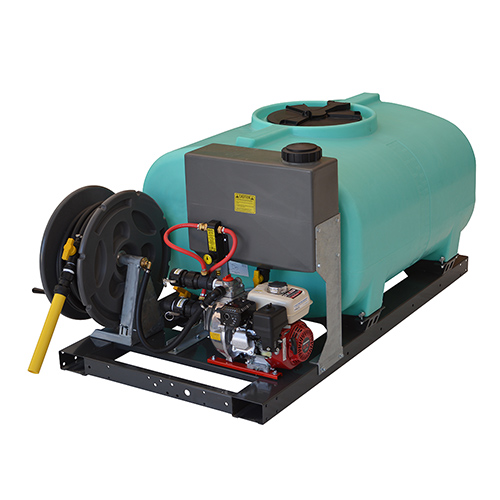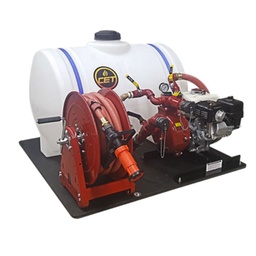- All Products
- Wildland CET Econo Pac Bush Buggy Package - Estimate showing, price available on request
Wildland CET Econo Pac Bush Buggy Package - Estimate showing, price available on request
Freight and crating is extra

Pumps
Wildland CET Econo Pac Bush Buggy Package – Lightweight, Efficient, and Ready for Rapid Response 🚒
The CET Econo Pac Bush Buggy Package is a compact, drop-in skid unit designed for wildland and urban interface firefighting. This all-in-one assembly combines a 65-gallon baffled water tank, a high-pressure portable fire pump, and a live hose reel—making it an ideal fit for small trucks, trailers, or utility vehicles where agility and speed matter most[1][2].
Key Features:
- Portable Drop-In Design:
- The entire unit is preassembled on a durable 3/4” polypropylene platform with under-lifting area for easy installation and removal.
- Fits most pickup beds, trailers, or UTVs—perfect for municipal, industrial, or forestry use[1][2].
- Pump & Engine:
- 6.5hp Honda GX200 Engine (manual start) powers a CET high-pressure, self-priming fire pump.
- Pump Performance:
- Max Flow: 75 GPM @ 10 PSI
- 65 GPM @ 50 PSI
- 45 GPM @ 100 PSI
- 35 GPM @ 125 PSI
- Max Pressure: 140 PSI
- Standard operational flow: 20 GPM @ 125 PSI[1][2].
- Water Tank:
- 65-gallon capacity, fully baffled to minimize water slosh and improve vehicle stability.
- Tank fill and recirculating valves for fast refills and pump cooling[1][2].
- Hose and Reel:
- Manual rewind hose reel with 50’ x 3/4” booster hose for quick deployment.
- Forestry nozzle included for versatile firefighting applications.
- Plumbing & Controls:
- 1.5” inlet and outlet with caps and chains.
- 1” valve for hose reel, 1” valve for tank fill/recirculation.
- Manifold outlet for flexible hose setup.
- Pump control panel for easy monitoring and operation.
- Lightweight Construction:
- Dry Weight: ~250 lbs; Wet Weight: ~750 lbs (with full tank)[1][2].
- Easy to move and install by two people.
Actionable Tips:
- Pre-Deployment:
- Check fuel and water levels, and ensure the hose and connections are free of leaks and blockages before every run.
- Practice mounting and dismounting the unit for rapid deployment in the field.
- Operation:
- Use the booster hose for direct attack, mop-up, or exposure protection.
- Use the recirculation valve to keep the pump cool if not actively flowing water.
- Maintenance:
- Drain and clean the tank regularly to avoid sediment buildup.
- Inspect and lubricate the hose reel and pump as per manufacturer recommendations.
Alternative Perspectives:
- For Larger Incidents: Consider a larger tank or foam system if you regularly respond to extended wildland fires or interface incidents.
- Foam System Add-On: While the standard Econo Pac is water-only, a compressed air foam system (CAFS) or around-the-pump foam system can often be added as an upgrade for improved suppression and efficiency.
Quick-Start Deployment Guide for the Econo Pac Bush Buggy Package 🚒
Preparation:
- Inspect the Unit:
- Check fuel and water levels and inspect the hoses, connections, and pump for any signs of wear or damage.
- Ensure the manual rewind hose reel is operational and the forestry nozzle is securely attached.
- Safety Check:
- Confirm all operators are equipped with appropriate PPE.
- Review the control panel layout and familiarize yourself with the engine start and stop procedures.
Setup:
- Position the Unit:
- Secure the skid unit onto the truck bed or trailer, ensuring it is stable and properly fastened.
- Ensure the lifting area is clear and accessible for any repositioning needs.
- Connect Hoses:
- Attach the booster hose to the reel and connect any additional hoses to the manifold outlets as needed.
- Prepare the Pump:
- Prime the pump manually if necessary, following the manufacturer’s instructions.
Operation:
- Start the Engine:
- Engage the choke if necessary and pull the starter cord on the Honda GX200 engine.
- Allow the engine to warm up before engaging the pump.
- Engage the Pump:
- Open the appropriate valves for the tank-to-pump and hose reel, and monitor the pressure gauge to achieve the desired flow rate (20 GPM @ 125 PSI is standard for many applications).
- Deploy Hose and Apply Water:
- Use the manual rewind feature to deploy the hose, directing the nozzle as needed for effective fire suppression.
Post-Operation:
- Shutdown:
- Close the valves and throttle back the engine before turning it off.
- Use the manual rewind to retrieve the hose.
- Maintenance:
- Drain any remaining water from the tank and hoses.
- Clean the pump and hose reel, and perform regular maintenance checks to ensure ongoing reliability.
Comparison with Larger or Foam-Equipped Packages:
Larger Bush Buggy Packages:
- Pros:
- Greater water capacity (up to 500 gallons) for extended operations.
- More powerful pumps for higher flow rates and pressure.
- Often include electric hose reels for faster deployment and retrieval.
- Cons:
- Heavier and less maneuverable, requiring larger vehicles for transport.
- Higher cost and maintenance requirements.
Foam-Equipped Packages:
- Pros:
- Enhanced fire suppression capabilities, particularly effective for creating fire breaks and handling complex fires.
- Can significantly reduce water usage.
- Cons:
- Requires additional training for foam use and proportioning.
- Foam concentrates add to operational costs and require careful storage and handling.
Econo Pac Package:
- Pros:
- Lightweight, portable, and affordable—ideal for quick response and smaller scale incidents.
- Simple operation with minimal setup time, suitable for initial attack and support roles.
- Cons:
- Limited water capacity and pump power compared to larger units.
- Lacks integrated foam system, reducing versatility for certain fire scenarios.
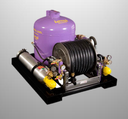

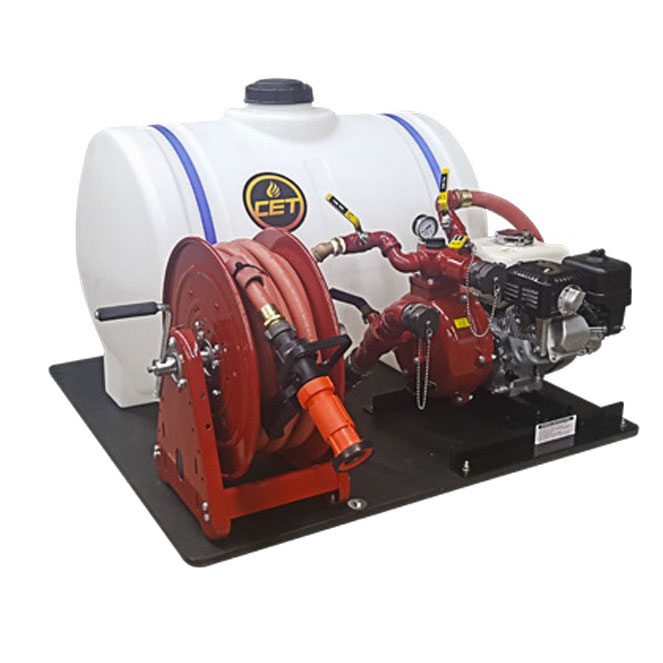
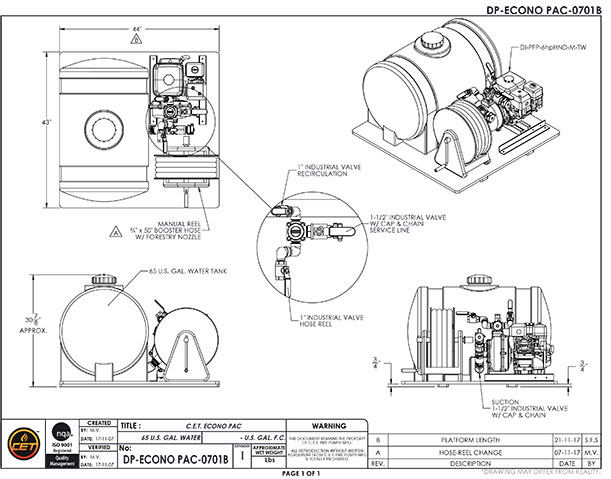


![[710000915] Wildland CET Attack Pac Bush Buggy Package - Estimate showing, price available on request](https://cdn.wfrfire.com/web/image/product.template/449/image_512/%5B710000915%5D%20Wildland%20CET%20Attack%20Pac%20Bush%20Buggy%20Package%C2%A0-%20Estimate%20showing%2C%20price%20available%20on%20request?unique=b80b281)
![[710001147] Wildland CET Forest Pac Bush Buggy Package - Estimate showing, price available on request](https://cdn.wfrfire.com/web/image/product.template/451/image_512/%5B710001147%5D%20Wildland%20CET%20Forest%20Pac%20Bush%20Buggy%20Package%C2%A0-%20Estimate%20showing%2C%20price%20available%20on%20request?unique=b80b281)
![[710001526] Wildland CET Ready Pac Bush Buggy Package - price available on request](https://cdn.wfrfire.com/web/image/product.template/452/image_512/%5B710001526%5D%20Wildland%20CET%20Ready%20Pac%20Bush%20Buggy%20Package%20-%20price%20available%20on%20request?unique=b80b281)
![[710001037] Wildland CET Skeeter Space Pac Bush Buggy Package -- Estimate showing, price available on request](https://cdn.wfrfire.com/web/image/product.template/453/image_512/%5B710001037%5D%20Wildland%20CET%20Skeeter%20Space%20Pac%20Bush%20Buggy%20Package%20--%20Estimate%20showing%2C%20price%20available%20on%20request?unique=b80b281)
